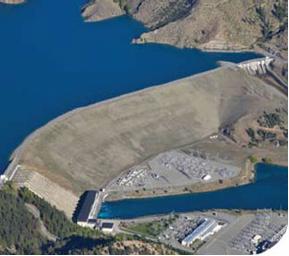Anti-gravity power device – 11th Entry into the Wild Energy Challenge – Please Cast Your Vote
This is an entry into the Adult section of Wild Energy. If you like this entry please give it a rating out of five stars (see the bottom of this page).
Here is my idea for a better future of power generation – by Ian Burgers
The graphic (above) shows it all really – The red floats are attached together by a chain which is needed to turn the two shafts. On one side, the weight of

An idea could be to install a row of the units onto existing dams (side by side) – large scale, big floats and the already high wall to create more power on the dams that have been built.
the floats in air pulls the chain downwards. During this process the chain turns a camshaft which moves the two specially timed sliding gates to let the tapered floats through into the water chamber.
This is designed similar to the floodable airlock system used in submarines which will minimise the downwards pressure from the water on the floats. There would only be one door fully open at any time to reduce water loss and flow against each individual float.
Once in the chamber the floats are forced to rise to the surface thus pulling up on the chain. This is where most of the power generation would take place (imagine trying to hold an empty
barrel at the bottom of a swimming pool)! The chain moves over the top shaft which is connected to a generator.
An important feature of the design is that the depth of the water chamber must be substantial (larger designs would be 10s of meters high), and there should be a small gap between the float and the wall in the ‘waterlock’ to allow floatation to take place.

It could also be built into council water tanks which would have the added bonus of being close to towns thus having less transmission losses.
In both cases it would be cheaper and greener done that way as one side of the unit is already being used. Rural houses could have smaller models – there could be one for every household in remote areas where top up water is plentiful. (Important note: This top up water would NOT come from a new dam, but possibly from an existing water supply for farm water troughs, etc). The power able to be produced is a bit unknown, but it would be scalable depending on the float size and the height of the chamber.
The cost to build this gadget? – Approximately $1000 each – this being the expected cost of the domestic version being a very rough estimate. The running costs however would be low with only bearing and door seal replacements being necessary.
I have not built a prototype but I think it possibly could work. There would be some water loss of course which would be a limiting factor but I think it is more worthwhile pursuing this than the proposed Mokihinui dam!
loading...
loading...
Tags: green energy design




It seems to be a perpetuum mobile. And it really is perpetuum mobile. And never be working. Why? Because you need to push the water in between sliding gates out of the chamber. And for this you spend more energy than you get from the machinery. Sorry, it is only my opinion.
peace … miro novak
loading...
loading...
Miro is right, this device seems to violate the law of conservation of energy. What does it draw power from? The floaters are ‘dragged down’ while they’re underwater, and ‘held up’ in the air. You should build the prototype, just to figure out where your reasoning fails, but it won’t work.
loading...
loading...
Thank you for your comments; Miro – the plan would be not to push the water anywhere, a portion would simply drain away every time a new float is introduced into the chamber. If a float had to be physically pushed into the chamber at the bottom then the pressure on the float would be immense and it wouldn’t work. This is not what I am proposing.
Bart – Yes, there would be some form drag from the water applied to the floats as they rise to the surface and some applied from the air as gravity pulls them down, but there is also drag associated with a waterwheel, and that works does it not?!
loading...
loading...
Ian, you say that you simply drain water every time. I aggree, simply, but you need more energy to “make it simply” than you get from the system. That is whay it is perpetuum mobile and it will never work for you. Sorry.
peace … miro novak
loading...
loading...
Hi,
Mr. Ian , i read your idea.& comments. Both are good. i like your idea
Need some modification on sliding gate.whatever have to proof practically. If can get power from this system to can break the rule
loading...
loading...